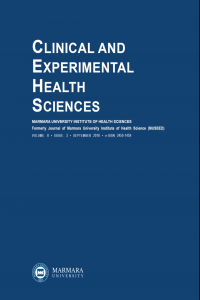Abstract
References
- Liu SS. A comparison of regional versus general anesthesia for ambulatory anesthesia: a meta-analysis of randomized controlled trials. Anesth Analg 2005; 101: 1634–42.
Does Patient-Controlled Infraclavicular Perineural Dexmedetomidine Increase the Duration of Postoperative Analgesia?
Abstract
Objective: Peripheral nerve blocks are now used widely for postoperative analgesia
and peripheral nerve catheters are widely utilized. Objective of this study was to
investigate effect of perineural infusion of dexmedetomidine on the duration of
postoperative analgesia retrospectively.
Material & Methods: A total of 60 patients aged between 18 and 65 years were
included in the study. Group 1 received infraclavicular patient-controlled perineural
bupivacaine (0.1 %). Group 2 received infraclavicular patient-controlled perineural
bupivacaine (0.1 %) + dexmedetomidine (200 mic/100 cc). Blood pressure, pulse,
peripheral oxygen saturation modified ramsay sedation scale, visual pain scores, total
amount of analgesics were recorded at the 0, 30, 60, 90 minutes and 2, 4, 6, 8, 12,
24 hours.
Results: Systolic blood pressure was higher in Group 1 at the hour 6 (p: 0.007).
Whereas, diastolic blood pressure was higher in Group 1 at the hours 4 and 6 (p:
0.000, p: 0.003). Heart rate was found to be higher in Group 2 at the hours 8, 12 and
24 (p: 0.004, p: 0.002, p: 0.002). Patients in Group 1 were found to significantly feel
pain and need analgesics at the hours 4 and 6 (p: 0.002, p< 0.05). The mean number
of patient requests for analgesia was 5.8±1.4 times in Group 1 and 2.2±0.4 in Group
2 (p<0,05). None of the patients developed sedation/neurological deficits.
Conclusion: Perineural infusion of dexmedetomidine combined with bupivacaine
was found to increase the duration of postoperative analgesia, reduce 24-hour need
for analgesia and have not any adverse efect at low doses.
References
- Liu SS. A comparison of regional versus general anesthesia for ambulatory anesthesia: a meta-analysis of randomized controlled trials. Anesth Analg 2005; 101: 1634–42.
Details
| Primary Language | English |
|---|---|
| Subjects | Health Care Administration |
| Journal Section | Articles |
| Authors | |
| Publication Date | September 28, 2018 |
| Submission Date | June 20, 2017 |
| Published in Issue | Year 2018 Volume: 8 Issue: 3 |


